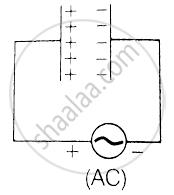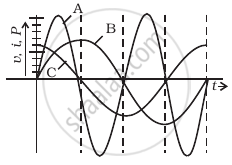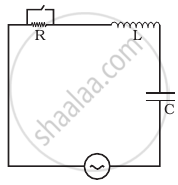Advertisements
Advertisements
Question
When an AC voltage of 220 V is applied to the capacitor C ______.
- the maximum voltage between plates is 220 V.
- the current is in phase with the applied voltage.
- the charge on the plates is in phase with the applied voltage.
- power delivered to the capacitor is zero.
Options
b and c
a and d
b and d
c and d
Solution
c and d
Explanation:
If the alternating voltage is applied to the capacitor, the plate connected to the positive terminal of the source will be at a higher potential and the plate connected to the negative terminal of the source will be at a lower potential. So the plate's capacitor is charged.

Power applied to circuit is `P_(av) = V_(rms) I_(rms) cos phi`
`phi` = 90° for pure capacitor circuit
∴ Pav = Vrms Irms cos 90° = 0.
APPEARS IN
RELATED QUESTIONS
Show that the current leads the voltage in phase by π/2 in an AC circuit containing an ideal capacitor ?
When an AC source is connected to a capacitor, there is a steady-state current in the circuit. Does it mean that the charges jump from one plate to the other to complete the circuit?
A current i1 = i0 sin ωt passes through a resistor of resistance R. How much thermal energy is produced in one time period? A current i2 = −i0 sin ωt passes through the resistor. How much thermal energy is produced in one time period? If i1 and i2 both pass through the resistor simultaneously, how much thermal energy is produced? Is the principle of superposition obeyed in this case?
Is energy produced when a transformer steps up the voltage?
The AC voltage across a resistance can be measured using
The dielectric strength of air is 3.0 × 106 V/m. A parallel-plate air-capacitor has area 20 cm2 and plate separation 0.10 mm. Find the maximum rms voltage of an AC source that can be safely connected to this capacitor.
A capacitor has capacitance C and reactance X, if capacitance and frequency become double, then reactance will be ______.
A device ‘X’ is connected to an a.c source. The variation of voltage, current and power in one complete cycle is shown in figure.
- Which curve shows power consumption over a full cycle?
- What is the average power consumption over a cycle?
- Identify the device ‘X’.

In the LCR circuit shown in figure, the ac driving voltage is v = vm sin ωt.
- Write down the equation of motion for q (t).
- At t = t0, the voltage source stops and R is short circuited. Now write down how much energy is stored in each of L and C.
- Describe subsequent motion of charges.

